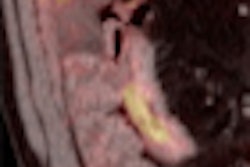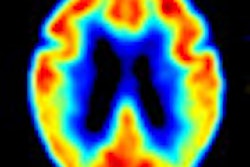A multicenter phase II clinical trial has found that a new SPECT radiopharmaceutical may have "significant utility" for diagnosing acute coronary syndromes long after symptoms have stopped, according to the July 20 issue of the Journal of the American College of Cardiology.
The radiopharmaceutical could help emergency department physicians decide how to treat patients who present with chest pain and other systems but who don't have high-risk findings. Many of these patients are discharged after their symptoms disappear, but they still have some risk of a cardiac event.
Researchers used the agent, called ß-methyl-p-[123I]-iodophenyl-pentadecanoic acid (BMIPP), with SPECT to detect abnormalities from myocardial ischemia as long as 30 hours after symptoms disappeared, which could enable physicians to identify the patients who are about to be discharged and might be at risk of a cardiac event. Lead study author is Michael Kontos, MD, from Virginia Commonwealth University in Richmond (JACC, Vol. 56:4, pp. 290-299).
Radiopharmaceutical developer Molecular Insight Pharmaceuticals of Cambridge, MA, is developing the molecular imaging agent under the brand name Zemiva.
BMIPP is a methyl fatty acid that is retained by myocardial cells. Previous research has found that persistent reductions in BMIPP uptake can be present more than a day after ischemic symptoms have subsided and can, in turn, extend the time physicians have to diagnose myocardial ischemia.
Multicenter trial
The study enrolled patients from emergency departments at 50 medical centers. All patients were 40 years of age and older and had no history of myocardial ischemia.
Patients were excluded from the study if they had a left ventricular ejection fraction of 40% or less, serum creatinine greater than 2.0 mg/dL, an allergy to x-ray contrast media or iodine/iodides, had received any other radiopharmaceutical other than rubidium-82 or thallium-201, or had undergone cardiac stress testing of any kind within two days before enrollment in the study.
Initial clinical diagnosis was based on symptoms, initial electrocardiograms, and troponin, whereas the final diagnosis was based on all available data, including angiography and stress SPECT. BMIPP SPECT was excluded from initial clinical diagnoses.
BMIPP protocol
A total of 507 patients received one injection of 5.0 mCi of BMIPP within 30 hours of their symptoms having stopped. Imaging then began within 10 minutes of BMIPP injection.
However, 59 people were excluded from the results, because they did not follow protocol or did not complete BMIPP SPECT imaging. There were 54 patients who did not have angiography or protocol-specified stress myocardial perfusion imaging (MPI) during the 30-day follow-up period. The remaining 448 patients underwent BMIPP SPECT and received a final diagnosis.
BMIPP SPECT was performed at a mean time of 11.9 hours after symptoms stopped. Imaging was performed more than 12 hours after chest pain cessation for 206 patients (46%), between 0 to less than 12 hours for 232 patients (52%), and chest pain was constant for 10 (2%) patients.
Of 448 BMIPP images in the efficacy population, image quality was rated as excellent, good, or diagnostic in 96% to 99% of cases among three readers who were blinded to the sensitivity of BMIPP.
Increased sensitivity
For diagnosing acute coronary syndrome, BMIPP SPECT alone achieved greater sensitivity at 73% than initial clinical diagnosis at 43%. When combining information from the initial clinical diagnosis with BMIPP SPECT, sensitivity increased to 81%.
"This increase in sensitivity was associated with no change in specificity, because the specificity of BMIPP SPECT imaging alone was similar to that of the initial clinical diagnosis alone (63% versus 61%, respectively)," the authors wrote. "The specificity of the combination of initial clinical information and BMIPP SPECT imaging was also similar (62%)."
The combination of BMIPP SPECT and clinical diagnosis also increased the test's negative predictive value (NPV) to 83%, compared with 62% for initial clinical diagnosis alone. Positive predictive value (PPV) also increased to 58% with the addition of BMIPP SPECT, compared with 41% for the initial clinical diagnosis alone.
|
The results also would indicate BMIPP has a rather benign effect on most patients. Among the 507 patients who received BMIPP, 109 patients (21%) reported a total of 209 adverse events. Of the adverse events, the study concluded that 164 (78%) events were unrelated to BMIPP use. The most common adverse event was headache by four patients. No events were rated as severe.
Kontos and his colleagues concluded that imaging fatty acid metabolism with BMIPP SPECT in emergency department patients with suspected acute coronary syndromes "has sensitivity similar to that of other contemporary imaging modalities, although it has the unique property of maintaining sensitivity even when performed up to 30 hours after symptom resolution."
Incremental value
The addition of BMIPP data to the initially available clinical information adds incremental value for the early diagnosis of an acute coronary syndrome, potentially allowing determination of the presence or absence of the condition to be made much earlier in the evaluation process.
The authors also noted limitations to the study. Among them was the patient sample itself, which was a nonconsecutive observational population of patients consenting to the trial. "The prevalence of [acute coronary syndromes] is higher than in other purely observation series of patients undergoing imaging on clinical grounds and in other trials," they noted.
In addition, "approximately 10% of the patients did not have sufficient information to make a final diagnosis and were prospectively excluded from the analysis of BMIPP performance characteristics," the authors wrote.
To counter the limitations, the authors also stated that strengths of the analysis include the fact that BMIPP SPECT was "performed in many more centers than had been previously reported in trials, with diagnostic image quality in the vast majority of patients."
By Wayne Forrest
AuntMinnie.com staff writer
July 19, 2010
Related Reading
SPECT MPI detects increased risk of sudden cardiac death, July 14, 2010
Coronary CTA identifies ACS patients ready for ED discharge, December 9, 2008
MRI evaluation of chest pain cuts acute coronary syndrome, August 15, 2008
New growth for diagnostic radiopharmaceuticals, November 9, 2006
Copyright © 2010 AuntMinnie.com




















